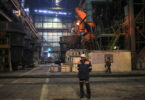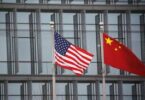Inga Velanskaya
Russia will expand its simplified visa regime to eight airports in the Far East region of the country by the end of this year, reflecting a drive by Moscow to further open up the resource-rich, vast area facing the Pacific coast to more investors and tourists.
Russian President Vladimir Putin’s backing for the new Far East economic policy created the special economic zone known as the Free Port of Vladivostok in 2015.It offers low tax rates and other benefits that so far attracted several hundred companies and about US$6.1 billion in investment pledges.
Allowing visa applications online for stamping on arrival has also generated a spike in tourists to Vladivostok, with thousands of visitors from China, which has a land border with the area, South Korea and elsewhere using the system since it was introduced in August.
“The Far East shares a border with some of the most dynamically developing economies in the wor-ld,”Alexander Galushka, Russia’s Minister for Develo-pment of the Far East, said in July in an interview. “It’s key for us to harness that economic power for the benefit of developing our eastern territories.” Beside expanding the visa system to more regions of Russia’s Far East, such as Sakhalin, Kamchatka and Chukotka, and for more nationalities, Putin has authorised funding for construction of new border crossing points in the Far East.
Procedures for hiring foreign personnel in the Vladivostok Free Port have also been simplified, authorities say. For investors, the port offers a zero-tax rate for five years on land and property, income tax is set at a maximum 5%, and it claims to streamline administrative procedures, such as obtaining permits for construction projects. Chinese make up the largest number of foreign investors, overseeing projects estimated at $1.3 billion, followed by Japanese and South Koreans, according to local authorities. One project is a truck assembly plant joint venture between Russia’s Sumotori Group and Chinese automaker First Automobile Works. Using parts from China it will assemble and sell Chinese FAW model trucks.
“Of the announced projects, a few dozen are at the construction phase and a few have started the first phase of operations, so the real benefits of the Free Port regime will be evident in about three years times and we can assess it then,” said Pavel Volkov, Deputy Minister for the Development of the Far East. Investment took off in Russia’s Far East from 2000 to 2005 when oil and gas projects in the Sakhalin Oblast territory attracted about 96% of foreign direct investment. Since then, mining, infrastructure and agriculture has attracted more attention.
In total, the region attracted $37 billion of private investment, but the goal is to reach $67 billion by the end of 2017, said Development Minister Galushka in July.
One lesson from the Vladivostok Free Port is that smaller can be better.
The port zone regulations were written with grandiose construction projects in mind, but no one was interested in such large-scale developments, said Maxim Krivelevich, a financial consultant and expert on the port zone. “But, the zone has worked for small and medium-sized businesses and hundreds have started to turn a significant profit in the second year of operation,” he said. Success depends on adapting business models to Russia and learning to work with local officials and complicated financial legislation, said Krivelevich.
“Foreign investors need to study Russian legislation, everything depends on how you understand and fill out documentation,” he said, adding this is especially true in determining tax exposure.
To deal with disputes, Russia will set up specialized financial courts for investors in the Vladivostok Free Port, using a model developed in China.
“It’s very important to introduce special institutions in the Far East that can help improve legal conditions,” Boris Titov, a former business ombudsman, said. “We can use the experience of China. There they have used such commercial courts in special economic zones.”
According to financial consultant Krivelevich, the Free Port of Vladivostok is the first truly successful example of major social and economic development in post-Soviet Russia.
“The free port has massive potential.
Once its framework includes measures that ease draconian currency regulations and the prohibitive entry rules for foreign investors in so-called strategic sectors of the economy – financial industries such as insurance and banking – then the free port will become a true locomotive for the nation’s economy,” said Krivelevich. “So, we have a unique opportunity. It’s already being seized upon and things are already rolling.”






